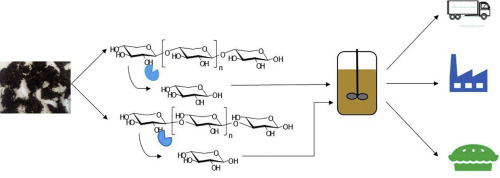当前位置:
X-MOL 学术
›
BBA Proteins Proteom.
›
论文详情
Our official English website, www.x-mol.net, welcomes your
feedback! (Note: you will need to create a separate account there.)
Xylanases from marine microorganisms: A brief overview on scope, sources, features and potential applications.
Biochimica et Biophysica Acta (BBA) - Proteins and Proteomics ( IF 2.5 ) Pub Date : 2019-11-16 , DOI: 10.1016/j.bbapap.2019.140312 Fatemeh Izadpanah Qeshmi 1 , Ahmad Homaei 1 , Pedro Fernandes 2 , Roohullah Hemmati 3 , Bauke W Dijkstra 4 , Khosro Khajeh 5
Biochimica et Biophysica Acta (BBA) - Proteins and Proteomics ( IF 2.5 ) Pub Date : 2019-11-16 , DOI: 10.1016/j.bbapap.2019.140312 Fatemeh Izadpanah Qeshmi 1 , Ahmad Homaei 1 , Pedro Fernandes 2 , Roohullah Hemmati 3 , Bauke W Dijkstra 4 , Khosro Khajeh 5
Affiliation

|
Global economic growth often leads to depletion of raw materials and generation of greenhouse gases, as industry manufactures goods at ever increasing levels to keep up with the demand. The currently implemented production processes mostly rely on non-renewable resources, they suffer from high energy consumption, and generate waste that often has a negative environmental impact. Eco-friendly production methods are therefore intensely searched for. Among them, enzyme-based processes are appealing, because of their high substrate and reaction specificity and the relatively mild operation conditions required by these catalysts. In addition, renewable raw materials that allow sustainable production processes are also widely explored. Marine xylanases, which catalyze the hydrolysis of xylan, the major component of lignocellulose, are promising biocatalysts. Since they are produced by microorganisms that thrive in a wide variety of environmental conditions, the enzymes may be active at widely different ranges of pH, temperature, and salt concentrations. These properties are important for their successful application in various industrial processes, such as production of bioethanol, bleaching of paper and pulp, and in the food and feed sector. The present work gives a brief overview of marine sources of xylanases, their classification and features, and of the potential applications of these marine enzymes, especially in sustainable processes in the scope of circular economy.
中文翻译:

海洋微生物中的木聚糖酶:范围,来源,特征和潜在应用的简要概述。
全球经济增长通常会导致原材料枯竭和温室气体的产生,因为工业生产的商品水平不断提高,以适应需求。当前实施的生产过程主要依赖于不可再生资源,它们遭受高能耗,并产生经常对环境造成负面影响的废物。因此,人们一直在寻找环保的生产方法。其中,基于酶的方法因其高的底物和反应特异性以及这些催化剂所需的相对温和的操作条件而具有吸引力。另外,还广泛探索了允许可持续生产过程的可再生原材料。海洋木聚糖酶催化木聚糖的水解,木聚糖是木质纤维素的主要成分,是有前途的生物催化剂。由于它们是由可在各种环境条件下壮成长的微生物产生的,因此这些酶可能在广泛不同的pH,温度和盐浓度范围内具有活性。这些特性对于它们在各种工业过程中的成功应用至关重要,例如生物乙醇的生产,纸张和纸浆的漂白以及在食品和饲料领域。本工作简要概述了木聚糖酶的海洋来源,其分类和特征,以及这些海洋酶的潜在应用,特别是在循环经济范围内的可持续过程中。这些特性对于它们在各种工业过程中的成功应用至关重要,例如生物乙醇的生产,纸张和纸浆的漂白以及在食品和饲料领域。本工作简要概述了木聚糖酶的海洋来源,其分类和特征,以及这些海洋酶的潜在应用,特别是在循环经济范围内的可持续过程中。这些特性对于它们在各种工业过程中的成功应用至关重要,例如生物乙醇的生产,纸张和纸浆的漂白以及在食品和饲料领域。本工作简要概述了木聚糖酶的海洋来源,其分类和特征,以及这些海洋酶的潜在应用,特别是在循环经济范围内的可持续过程中。
更新日期:2019-11-16
中文翻译:

海洋微生物中的木聚糖酶:范围,来源,特征和潜在应用的简要概述。
全球经济增长通常会导致原材料枯竭和温室气体的产生,因为工业生产的商品水平不断提高,以适应需求。当前实施的生产过程主要依赖于不可再生资源,它们遭受高能耗,并产生经常对环境造成负面影响的废物。因此,人们一直在寻找环保的生产方法。其中,基于酶的方法因其高的底物和反应特异性以及这些催化剂所需的相对温和的操作条件而具有吸引力。另外,还广泛探索了允许可持续生产过程的可再生原材料。海洋木聚糖酶催化木聚糖的水解,木聚糖是木质纤维素的主要成分,是有前途的生物催化剂。由于它们是由可在各种环境条件下壮成长的微生物产生的,因此这些酶可能在广泛不同的pH,温度和盐浓度范围内具有活性。这些特性对于它们在各种工业过程中的成功应用至关重要,例如生物乙醇的生产,纸张和纸浆的漂白以及在食品和饲料领域。本工作简要概述了木聚糖酶的海洋来源,其分类和特征,以及这些海洋酶的潜在应用,特别是在循环经济范围内的可持续过程中。这些特性对于它们在各种工业过程中的成功应用至关重要,例如生物乙醇的生产,纸张和纸浆的漂白以及在食品和饲料领域。本工作简要概述了木聚糖酶的海洋来源,其分类和特征,以及这些海洋酶的潜在应用,特别是在循环经济范围内的可持续过程中。这些特性对于它们在各种工业过程中的成功应用至关重要,例如生物乙醇的生产,纸张和纸浆的漂白以及在食品和饲料领域。本工作简要概述了木聚糖酶的海洋来源,其分类和特征,以及这些海洋酶的潜在应用,特别是在循环经济范围内的可持续过程中。











































 京公网安备 11010802027423号
京公网安备 11010802027423号